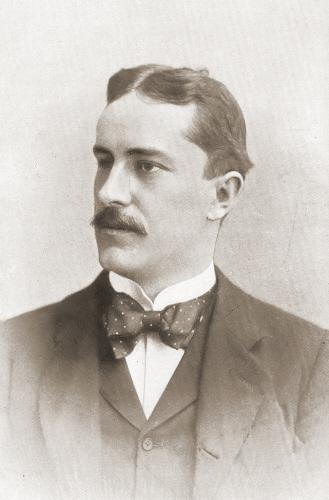
Edward Winter

***
A miscellany of Chess Notes items concerning Richard Teichmann (1868-1925).
The following miniature is well known:
Richard Teichmann – N.N.
(Remove White’s queen’s rook.)
1 e4 d5 2 exd5 Qxd5 3 Nc3 Qd8 4 Nf3 Bg4 5 Bc4 e6 6 h3 Bxf3 7 Qxf3 c6 8 d3 Qf6 9 Qg3 Nh6 10 Bg5 Qg6 11 Nb5 cxb5
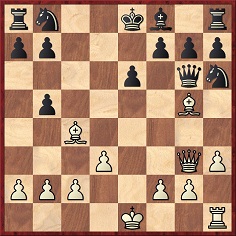
12 Qxb8+ Rxb8 13 Bxb5 mate.
A number of books, including the 1970/71 and 1995 editions of Jack Spence’s monograph on Teichmann, give the occasion as a simultaneous exhibition in Zurich in 1920. However, Richard Forster (Winterthur, Switzerland) points out that the score appeared on page 108 of a book published six years earlier: Schachmeisterpartien des Jahres 1914, Band II, by Bernhard Kagan. The venue is not specified, but Kagan states that White gave the odds of his queen’s rook.
(2141)
Addition on pages 106-107 of Kings, Commoners and Knaves:
Richard Forster has now found the game on pages 123-124 of the August 1914 Schweizerische Schachzeitung, which took it from the Hamburger Nachrichten. It is stated that White did give the odds of his queen’s rook and that the game was ‘played recently at the Café Kerkau in Berlin’.
Peter Anderberg (Harmstorf, Germany) notes that the famous short game was played a little earlier than previously thought:
‘I have located the game-score in Tägliche Rundschau (supplement) of 3 September 1913, page 820. White gave the odds of his queen’s rook, and the game was “played recently at the Café Kerkau”. It was subsequently reprinted in, for example, the Hamburger Nachrichten, 3 May 1914 and the Deutsche Schachzeitung, October 1914, page 319.’
(3299)
It cannot be often that an annotator misunderstands the result of a game. In The Chess Career of Richard Teichmann (Nottingham, undated) Jack Spence gives the game Capablanca v Teichmann mentioned in C.N. 617. The slip of printing 23 P-B4 instead of 23 P-B3 (both moves are possible in the position) is nothing compared to J.S.’s astonishing claim that the game was drawn, in a bishops of opposite colour ending when the Cuban was a pawn up. How did this mistake arise when the correct score may be found in dozens of different books?
(928)
‘Chess is 99% tactics’ is a famous quotation, usually ascribed to Richard Teichmann. The best corroboration we can offer comes from page 134 of volume 4 of Schachtaktik by E. Voellmy (Basle, 1930):
‘Zu meinem Trost hat der grosse Meister und Lehrer Teichmann mir vor Jahren in Zürich auseinandergesetzt (wobei er leicht übertrieb): “Das Schach besteht zu 99% aus Taktik”.’
(2307)
A quote from page 3 of The Middle Game in Chess by Reuben Fine (New York, 1952):
‘Among players of equal strength, it is always the last blunder, and the ability to see it, that determines who will win. At every level of chess skill, including the world championship class, it is still true that tactics is 99 per cent of the game.’
(2339)
A footnote on page 342 of A Chess Omnibus mentioned that many variations have been seen. For instance, on page 137 of the July 1955 Chess World C.J.S. Purdy wrote, ‘Kostić once said chess was 90% tactics, and he was right – not necessarily in the precise figure but in the general idea it conveys.’
From Better Chess by William Hartston (London, 1997 and 2003):
‘Think strategies when it’s your opponent’s turn to move; sort out the tactics while your own clock is running.’ (Page 50 of the latter edition.)
(5884)
See also C.N. 5889.
From page 103 of Chess Rules of Thumb by Lev Alburt and Al Lawrence (New York, 2003):
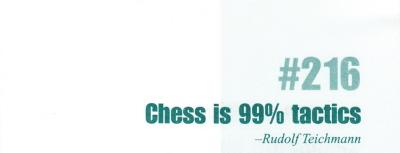
‘Rudolf’ Teichmann is unknown in the chess world.
The following was on page 97 of Chess Marches On! by Reuben Fine (New York, 1945):
‘Thirty years ago Teichmann said that chess is 99% tactics.’
(8738)
On page 98 Fine added:
‘Tactics is still more than 90% of chess.’
On page 181 of his book Wonderful world of chess (published by ‘Chess press, Munchen’, undated) Dimitrije Bjelica attributed to Teichmann (‘Teichman’): ‘Chess is 99 of tactisc.’
On page 195 of The Art of Positional Play (New York, 1976) Reshevsky agreed with the remark regularly ascribed to Teichmann, ‘Chess is 99% tactics’.
An addition on the same theme comes from an article entitled ‘Der neue Bilguer’ by Josef Krejcik on pages 230-232 of the August-September 1913 Wiener Schachzeitung:
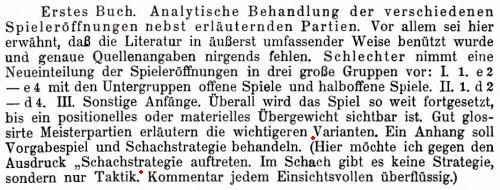
The marked passage states:
‘Here I wish to speak out against the term “chess strategy”. In chess there is no strategy, but only tactics.’
See also Chess Strategy and Tactics.
In the light of the recent discussion of Carlsbad, 1911 (e.g. on pages 8-9 of the 6/1999 New in Chess), it is worth recalling the opinion of Wolfgang Heidenfeld, given on page 33 of the January 1971 BCM (in a review of the BCM’s reprint of the tournament book):
‘The reviewer of Carlsbad 1911 is handicapped by the author: in his autobiographical work Goldene Schachzeiten Dr Vidmar calls it “the worst book I have ever written simply because it carried the shabbiest fee I have ever received”. Let me, however, say at the outset that, though not one of the great tournament books (in the class of St Petersburg 1914, New York 1924, Carlsbad 1929, Zurich 1959 or Santa Monica 1966) it is a good deal better than any of the tournament books edited by Bogoljubow, Maróczy and Teichmann, easily the three most boring authors of tournament books, and quite a bit above many other books not fathered by either [sic] of these three prize bores.’
(2322)
On pages 132-133 of L’Echiquier, July 1925, Alekhine wrote an obituary of Teichmann in which he presented an overview of the development of chess theory:
‘His death marks the loss of one of the last representatives of the “classical” school, the principles of which were established and disseminated chiefly by Dr Tarrasch, who simplified them and thus made understandable for the public at large the brilliant, though sometimes excessively complex, ideas of Steinitz, the great forerunner.
The three basic principles of the school may be summarized as follows:
1. The importance of the pawn centre.
2. Exploitation of weaknesses in the enemy position.
3. The concept of free play, which was considered the objective of opening strategy.
However correct they may be, these principles, taken too narrowly and applied rigidly, gradually contributed to the decline of the “classical” school (“pseudo-classical”, in our view), and its rare devotees (Spielmann, for example) are now able to achieve merely succès d’estime in their major battles – despite all their innate talent.
Far from denying the validity of the above-mentioned principles, the representatives of the young generation take them as the very basis of their conception but interpret them more profoundly.
1. They replace the notion of pawn centre by centre alone, i.e. the central squares, domination of which – even by pieces – is the true aim of opening strategy.
2. Instead of exploiting a weak point, they prefer, in principle, the exploitation of a group of squares which have been weakened by, for instance, the disappearance of an enemy piece (a bishop which controlled the squares in question) or thanks to a special pawn configuration leaving the squares without defence.
3. The pieces’ freedom of action in the opening is subordinate to the need to create, from the very first moves, a harmonious plan of development which has the concrete aim of weakening the enemy position. Thus freedom of action takes on real importance only if it can contribute to exploiting an advantage acquired.
Teichmann belonged to the generation of Tarrasch, Pillsbury, Schlechter, Maróczy, etc. To the end of his days, he would not hear of these new ideas, which were so different from the ones familiar to players of his generation. This, in our view, explains his relative lack of success in recent years.
Even so, for about 20 years Teichmann was one of the most formidable tournament players, and he almost always achieved a highly respectable placing. His great success was at the Carlsbad tournament of 1911, where he won first prize, ahead of 26 [sic; 25] of the best players of the time.
… Although Teichmann’s tournament results were very considerable, they do not in themselves give a wholly exact idea of his strength and, in particular, of his deep understanding of the spirit of chess – within the limits permitted by his period. Nor should it be forgotten that he was often at a disadvantage owing to his ill-health (he lost an eye when very young) or that, despite his wrestler’s build, he did not have the real temperament of a fighter and often settled for a draw in cases where his strength would have allowed him to aspire to victory.
In conclusion, another great chess figure has gone, and of those there are all too few.’
(2464)
Tartakower related an incident which occurred at Carlsbad, 1923:
‘… Teichmann, who did not like to overdo it, had accepted the draw offered by Réti when the tournament director, Mr Tietz, who considered that Teichmann had the better position and who “had his interests at heart”, refused to accept the decision and ordered the battle to continue. Teichmann then went for outright simplification … and soon sank. Was such a result not unfair?’
Source: Les Cahiers de l’Echiquier Français, issue 24, pages 244-245.
(2465)
C.N. 1658 (see page 22 of Chess Explorations) gave this position:
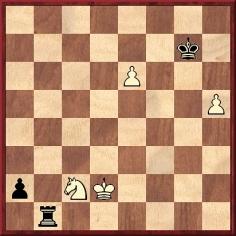
White to move
Play was said to have continued 44 h6+ Kxh6 45 e7 Rb8 46 Kc1 Kg7 47 e8(Q) Rxe8 48 Kb2 Re2 49 Ka1 Drawn. Our source was Verkhovsky’s book on drawn games; see page 27 of Nichya! (Moscow, 1972) or page 39 of the Spanish translation Tablas (Barcelona, 1973). The heading in each case was ‘Teichman v Marbl, Leipzig, 1913’, but it has still not been possible to corroborate this.
Now René Olthof (Rosmalen, the Netherlands) writes:
‘I have used the position in a training session at my chess club HMC. I believe that together with Harold van der Heijden I have discovered an analytical hiccup:
44 h6+ Kxh6 45 e7 Rb8 46 Kc1 Kg6 (rather than the illogical 46…Kg7) 47 e8(Q)+ Rxe8 48 Kb2 and, with the king on g6 instead of g7, 48...Ra8! suddenly wins. For example, 49 Ka1, when the obvious 49...Ra4? 50 Ne3! Kg5 51 Nd5! only draws, but 49...Kf5! 50 Nb4 Ke4 (or 50...Rb8) 51 Nxa2 Rb8! is a database win: 52 Nc1 Ke3 53 Ka2 Kd2! 54 Nb3+ Kc3 55 Nc5 Rd8 56 Ne6 Rd5, etc. In fact, 46...Kg5! may win even more quickly.’
We now notice that a correspondent’s contribution on this topic in C.N. 1839 (see page 23 of Chess Explorations) incorrectly reported as ‘La Stratégie, 1923’ the source of a study by Anatole Mouterde with the theme resulting from the above position. In fact, the composition first appeared in the French magazine’s January 1916 issue (page 27).
(2475)
Christian Sánchez (Rosario, Argentina) mentions that the position was given on pages 236-237 of How to Play Chess Endings by E. Znosko-Borovsky (London, 1940), the caption being ‘Teichmann v N., Berlin, 1913’.
Was White indeed Richard Teichmann, and how did the name ‘Marbl’ become involved?
(5201)
Hans-Georg Kleinhenz (Munich, Germany) points out that the game conclusion was given on page 335 of Die Schachwelt, 21 December 1912:
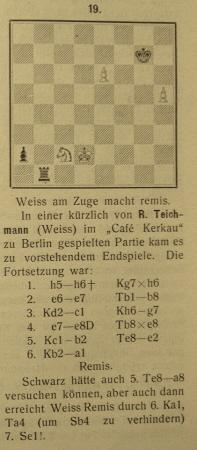
Our correspondent comments that since Richard Teichmann was a contributor to Die Schachwelt the item is likely to be based on first-hand information.
(5212)
From pages 6-7 of Chess Traps, Pitfalls, and Swindles by I.A. Horowitz and F. Reinfeld (New York, 1954):
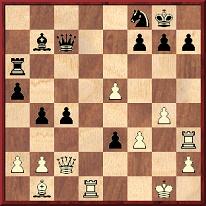
‘Teichmann was blind in one eye, but he had a keen sight of the board just the same. Having given up the exchange in return for a pawn, he is somewhat at a material disadvantage. After a careful study of the position he played 1...Rg6.
Tarrasch, at that time (1907) one of the world’s greatest masters, annotated this game for a newspaper column. Ridiculing Teichmann’s move, he pointed out that “of course 1...Qxe5 was the right move. If then 2 Qxc4 Rd6! 3 Rxd6?? e2! and Black wins on the spot!” Tarrasch added a number of sarcastic remarks and some involved variations which we need not go into here. His note was copied in columns and magazines the world over, with no dissenting voice.
Only when the book of the tournament (Carlsbad, 1907) appeared several years later did the chess world find out what Teichmann had seen with his one good eye. The fact is that [the above diagram] is the setting for a particularly devilish pitfall that Vidmar had set for his opponent. Tarrasch quite overlooked that 1...Qxe5?? is a fearful blunder.’
Horowitz and Reinfeld added that the reply would be 2 Qxh7+ Nxh7 3 Rd8+ Nf8 4 Rh8+ Kxh8 5 Rxf8 mate, but their narrative is incorrect, for the queen sacrifice was pointed out shortly after Tarrasch’s note appeared in the Deutsche Schachzeitung, which was three years before the tournament book was published.
The game was played on 7 September 1907, and Tarrasch’s annotations in the Berliner Lokalanzeiger of 15 November 1907 were given on pages 83-84 of the March 1908 Deutsche Schachzeitung.
The next issue of the magazine (i.e. April 1908, page 132) had the following:
‘Graz (F. Poljanec). Sie setzen S. 84 rechts, 26. Zug, nach Dc7xe5 (von Dr. Tarrasch empfohlen und von Schlechter approbiert) in fünf Zügen mat: 27 Dh7+: Sh7: 28 Te6+ [sic] usw. Uns wundert das nicht: Denn: Aliquando dormitat bonus Homerus!’
It may be added that, as shown by announcements in the Deutsche Schachzeitung and Wiener Schachzeitung, the Carlsbad, 1907 tournament book was not published until 1911. A number of catalogues, including those of the Cleveland and Hague libraries, give an incorrect publication year, as does the 1983 Olms reprint. The Vidmar v Teichmann game was on pages 301-303. See also page 73 of Goldene Schachzeiten by Vidmar.
We have found nothing to support Horowitz and Reinfeld’s assertion that Tarrasch’s faulty note ‘was copied in columns and magazines the world over’. In any case, Tarrasch later gave the mating line in his book Die Moderne Schachpartie (page numbers vary according to the edition).
(3711)
On page 256 of the May 1995 BCM Bernard Cafferty claimed that Bernstein missed a likely win against Teichmann at Carlsbad, 1911, and that the winning line was also overlooked by Vidmar in his tournament book.
Vidmar’s work on Carlsbad, 1911 ignores the matter because the game was played at Carlsbad, 1923. The tournament book of that event, not written by Vidmar, was reprinted in 1977 by the BCM.
(Kingpin, 1995)
A footnote on page 281 of Kings, Commoners and Knaves:
Printing a correction proved beyond Mr Cafferty’s capacity.
It is frequently stated that Emanuel Lasker and Richard Teichmann were born the same day, 24 December 1868, but were they? Richard Forster points out that when Teichmann died various obituaries in German magazines gave 23 December 1868, one example being on pages 198-199 of the July 1925 Deutsche Schachzeitung. Indeed, page 281 of Deutsches Wochenschach, 21 June 1925 specifically stated that 24 December was incorrect:
‘Teichmann war am 23. (nicht 24.) Dez. 1868 in Lehnitzsch in Sachsen-Altenburg geboren ...’
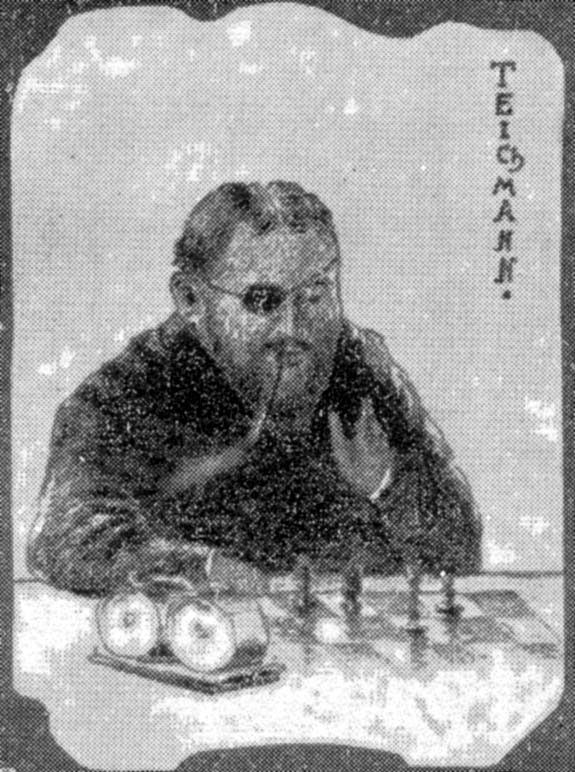
Richard Teichmann
(4058)
John Blackstone (Las Vegas, NV, USA) sends a brief report from page 3 of the New York Times, 26 June 1904. It begins:
‘Five of the masters who were competitors in the recent international chess tournament at Cambridge Springs, Penn. participated in a team match at the Brooklyn Chess Club Friday night [24 June], the sides being captained by Frank J. Marshall, winner of the international event, and Richard Teichmann, who was then finishing a three days’ engagement at the Brooklyn Club.
Marshall was in a reckless mood, chose an eccentric opening and made an unsound sacrifice, with the result that he lost his individual encounter with Teichmann at Board 1, after a long and far from uninteresting game.
Carl Schlechter, the Austrian champion, won his game from J.S. Jones, Vice President of the Western Chess Association, and A.W. Fox won from C. Jaffe. W.E. Napier and C.S. Howell were matched at the second board, and the game resulted in a draw. The match was won by Teichmann’s team on totals of five to four.’
The newspaper then listed the complete board results, but presented no moves. Mr Blackstone asks if anything further is known about the event and whether any games have survived.
The match was mentioned on page 217 of Napier The Forgotten Chessmaster by John S. Hilbert (Yorklyn, 1997), which gave the moves of Napier v Howell, but we have come across no other games. Can any reader trace them and, in particular, the Marshall v Teichmann game-score?
(4476)
From W.E. Napier’s Amenities and Background of Chess-Play (published in three ‘units’, the first two in 1934 and the third the following year). The figures refer to the item numbers, given that the pages were unnumbered:
115. [On the game Důras v Teichmann, Ostend, 1906]: ‘Důras needs no better monument to his genius than this lofty and exciting struggle with an eminent opponent. In my catalogue of genuinely great contests it rises up close to the top. It is chess all the way, but from move 43 it goes in a dignity unsurpassed.’
225. ‘Once while walking over Waterloo Bridge, in London, with stout-hearted Teichmann, we conversed of the ingredients that associate to make a chessplayer. I ventured a remark that, if he would name one indispensable ingredient, I would name an able player wholly destitute of it. And Richard very tolerantly said, “Have you given any thought to ‘vanity’?”’

Richard Teichmann (Hastings, 1895 tournament book)
John Blackstone provides this cutting from page 11 of the Brooklyn Daily Eagle, 7 September 1911:
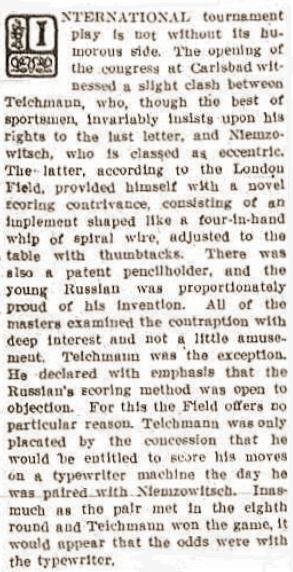
(6515)
John Blackstone has found a follow-up item on page 2 of the Brooklyn Daily Eagle, 19 October 1911:
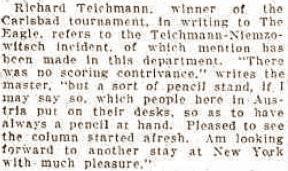
(6540)
From Oliver Beck (Seattle, WA, USA):
‘Richard Teichmann has often been referred to as a chessplayer who failed to achieve his potential. Alekhine’s remarks quoted on pages 394-395 of A Chess Omnibus provide an example, as do Jack Spence’s comments on page 4 of The Chess Career of Richard Teichmann 1892-1924 (Nottingham, 1971). Even in the Carlsbad, 1911 tournament book Vidmar states that Teichmann frequently finished fifth because he was comfortable in doing so, and only an “ungewöhnliche Stimulation” can have resulted in him playing as well as he did in that particular tournament (page 9).
Richard Teichmann
One wonders how great a player Teichmann could have been. On pages 119-120 of E.A. Michell’s The Year-Book of Chess, 1907 (London, 1907) the introduction to Teichmann v Janowsky, Ostend, 1906 states:
“A famous player once said that Teichmann had as much chess in him as any man living. If anyone doubts this we recommend a careful study of the beautiful and subtle game below.”
Who was that “famous player”?’
Our correspondent also notes the entry on Teichmann in Byrne J. Horton’s Dictionary of Modern Chess (page 204):
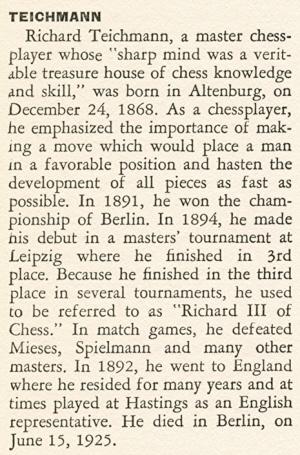
We add that the ‘sharp mind’ remark appeared in an article ‘The Triumph of Unreason’ by H. Kmoch and F. Reinfeld on pages 299-300 of the October 1950 Chess Review (see too pages 158-165 of Reinfeld’s The Treasury of Chess Lore). The full paragraph on Teichmann reads:
‘Another member of the “older” generation was Richard Teichmann (born 1868), whose sharp mind was a veritable treasure house of chess knowledge and skill. The unfortunate Teichmann had two handicaps: he lacked the vision of one eye and he was undoubtedly the laziest man that ever lived. Many of his games are unbearably lethargic, but when the slumbering chess genius of Teichmann roused itself he was capable of superhuman achievements. This he proved when he won the great Carlsbad tournament in 1911.’
On page 123 of The Unknown Alekhine 1905-1914 (New York, 1949) Reinfeld wrote:
‘Richard Teichmann, a phenomenally gifted master, was greatly handicapped by laziness and the loss of an eye. He was generally found in the middle of the prize list, and won so many fifth prizes that he was nicknamed Richard the Fifth. Paradoxically enough, his only important first prize was at Carlsbad, 1911 – one of the great tournaments of chess history.
Curiously enough, Teichmann’s phenomenal laziness was blended with equally phenomenal patience. The following game [Alekhine v Teichmann, Carlsbad, 1911] is a case in point.’
C.N. 929 (see page 122 of Chess Explorations) briefly mentioned Teichmann’s nickname, and the above discrepancy between ‘Richard III’ (Horton) and ‘Richard V’ will be noted.
We do not recognize the quote by the ‘famous player’ referred to by Mr Beck. As regards other views on Teichmann, Emanuel Lasker wrote in a ‘Berlin Letter’ dated 30 October 1907 about an 11-round tournament in that city which Teichmann had just won:
‘His victory confirms the opinion held by connoisseurs that Teichmann can easily beat the young crop of masters in a short tournament and in fact is a redoubtable opponent for anyone. In a drawn-out contest, however, the loss of his right eye always proves too severe a handicap.’
Source: Lasker’s Chess Magazine, November 1907, page 4.
After Teichmann’s victory at Carlsbad, 1911 Lasker wrote about him in the Berliner Zeitung am Mittag. The article, ‘Der Sieg Teichmanns’, was reproduced on pages 299-300 of the September-October 1911 Wiener Schachzeitung.
Other authoritative assessments of Teichmann’s skill and potential will be welcome.
(6620)
For another appellation, ‘Richard IV’, see C.N. 7557 below.
A celebrated finish (White to move) from an odds game played in Zurich circa 1920:
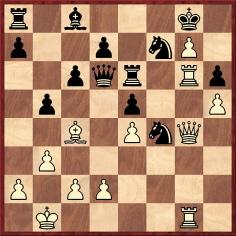
See, for instance, pages 184-185 of the August 1921 Deutsche Schachzeitung. Teichmann won with 1 Rxh6 Nxh6 2 Qg5 Nf7 3 Qd8+ Nxd8 4 h6.
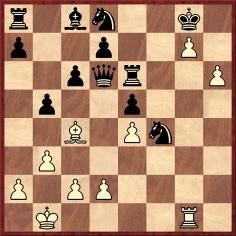
The full game-score is unavailable and, as shown on page 474 of Schachgesellschaft Zürich 1809 bis 2009 by Richard Forster (Zurich, 2009), few of the historical details are clear. Moreover, it was discovered many decades later that Black could have saved the game, and that is the focus of the present item.
On page 226 of Queen Sacrifice (Oxford, 1991) I. Neishtadt wrote that ‘in 1982 M. Dvoretsky found that in the final position [after 4 h6] Black can successfully defend’ by 4...Qd4 5 h7+ Kf7 6 g8(Q)+ Ke7 7 h8(Q) Kd6 8 Bxe6 Ndxe6.
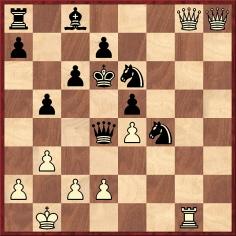
Neishtadt now observed that Black has at least equal chances ‘in the complicated battle to come’.
The following appeared on page 187 of Training for the Tournament Player by M. Dvoretsky and A. Yusupov (London, 1993):
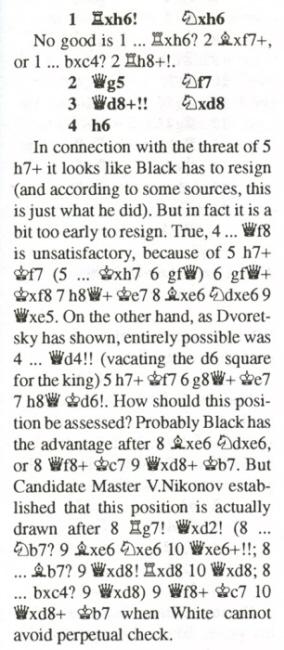
The quiz position had been given on page 120 in a chapter whose authorship was credited to Mikhail Shereshevsky. Exactly where and when was the move 4...Qd4 first pointed out?
(6820)

C.N. 6820 asked where and when the move 4...Qd4 (providing a haven for the black king at d6) was first pointed out.
Dennis Leong (Chicago, IL, USA) writes:
‘I first saw the move mentioned in Mark Dvoretsky’s “Masterskaya” column in the 18/1981 issue of the magazine 64, pages 12-13. In that column, Dvoretsky does not credit V. Nikonov with the discovery of 4...Qd4.’
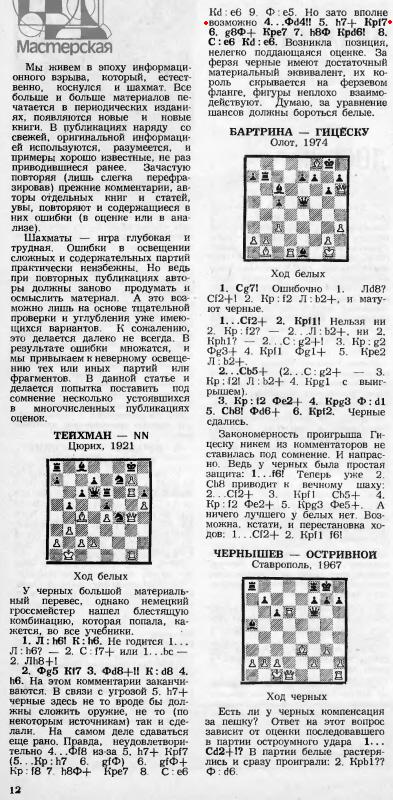
(6853)
A photograph from page xiii of Der internationale Schachkongress zu St Petersburg 1909 by Emanuel Lasker (Berlin, 1909), given in our feature article on the Macdonald v Burn brilliancy:
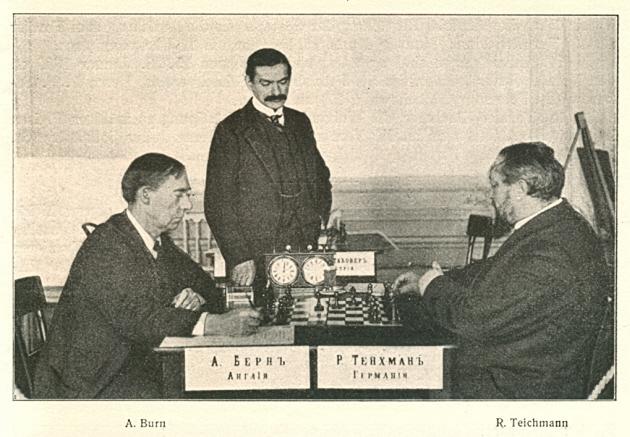
Moshe Rubin (Jerusalem) is researching John Francis Byrne (1880-1960), who lived in Dublin until 1910 and thereafter in New York City. In 1953 Byrne, a close friend and colleague of James Joyce, published Silent Years: An autobiography with memoirs of James Joyce and our Ireland, and we are grateful to Mr Rubin for sending us two chapters with much chess content.
Chapter Five (pages 48-57) is entitled ‘Congress v House of Commons at Chess’ and describes, in particular, Byrne’s games with John Howard Parnell. His encounters with some masters are related in Chapter Sixteen (‘I Lecture on Spinoza’) on pages 178-187. In the early part of the twentieth century ‘in this new Sackville Chess Club I quickly became a top chessplayer; and during several years won as many first-prize gold medals’. From pages 179-180:
‘As an indication of the standard of chess played in Dublin, I can relate a couple of facts. One afternoon in the Sackville Chess Club, I was sitting alone and unoccupied, when a middle-aged, stout and florid gentleman with a large blue patch over one eye approached me and asked me in Teutonic accent whether I would care to play a game of chess with him. I said I would and we did. And as the game progressed, I noticed to my astonishment that a big crowd of kibitzers gathered around our table. After we had played a while the game developed into what was, I knew, a winning position for me; and at this point I was amazed when my opponent suddenly stretched out his arm, swept all the pieces off the chessboard, and said, “It’s yours – will you play another?” We played again; and this time, before the game was finished he said, “It’s a draw – have another?” I refused to play a third, because I had to go away; and when I got up to leave, several members of the club clustered round me clapping me on the back, saying, “Well done, Byrne, you gave him quite a shock.” “But who is he, I never saw him before?”, I asked. “Didn’t you know? He’s Teichmann.”
Teichmann was at that time a prominent international chess master, who usually came out somewhere about fourth in the international tournaments. The Sackville Club had been in correspondence with him about giving some exhibitions in Dublin, and when he arrived he was met by Porterfield Rynd, who escorted him to the club where, without my being aware of what was afoot, he sicked him on to me. Rynd was very fond of a little practical joke. He himself was a really good player; and he knew, though I was not a student of chess, that I was a player who had a winning chance against anyone. Another chess master who came to Dublin for exhibition purposes was an Englishman named Lee. He also played in international tournaments, but usually did not do so well as Teichmann. With Lee I played a few solo games; and I felt quite sure that if I were to play a match with him I could beat him, but I also felt doubly sure that I never would play a serious match with him – or anyone else. The strange thing about Lee is that I remember him so vividly. If I were an artist, I could sketch him exactly as he appeared to me then. He looked to be in his middle fifties, about my own size, with long pasty face, grey eyes, sparse and thin greying hair brushed back from his forehead, large, but not protruding ears, thin grey moustache, a quiet manner, and soft, but slightly raucous voice, this quality in it being probably due to his continuous pipe smoking combined with his love for snuff. He wore a high collar, large cravat, frock coat, striped trousers and spats. And as I played with him and thought about him I marveled how in the name of heaven he was able to make both ends meet as an itinerant professional chessplayer. And the more I thought about Lee, or Teichmann for that matter, the less I wanted to play any professional chessplayer in those simultaneous exhibitions. In play either against Teichmann or Lee, I won a brilliancy prize; but instead of feeling elated over this, I felt sad. These fellows, I realized, were eking out a precarious existence dragging the devil by the tail, and I felt no glory in adding my poundage to his satanic majesty.
A third professional who visited Dublin in my time for exhibition purposes was the famous Blackburne. His exhibition in the Sackville Chess Club consisted of playing blindfolded against about eight players simultaneously. I was an emcee that night – relaying moves, and helping Rynd, who was a long-time personal friend of Blackburne’s, to prepare vast quantities of whiskey punch to slake the eager thirst of the aged, daddy-Christmas-looking chess master. And, inspired no doubt by his spirituous quaffing, Blackburne won a smashing victory.’
Our correspondent asks whether it is possible to find other writings on chess by Byrne, or any of his game-scores.
(6833)
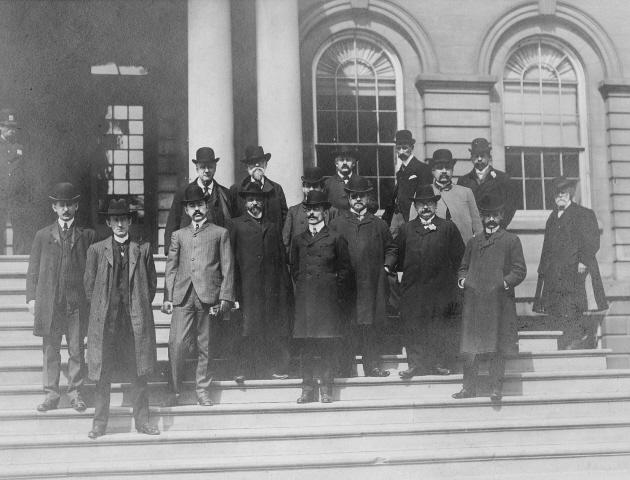
We offered a book prize for the best attempt by a reader to identify the above figures in a photograph forwarded by David DeLucia (Darien, CT, USA). It was a difficult task, even though some masters, such as Marshall, Janowsky, Teichmann and Schlechter, are immediately recognizable and even though, as will be seen, the photograph concerns a famous tournament.
The winner of our contest is Dominique Thimognier (Fondettes, France), and we can do no better than paraphrase his excellent entry, which identifies virtually the entire group.
The photograph shows players in, and organizers of, Cambridge Springs, 1904. Newspaper reports of the time mentioned by Mr Thimognier relate that eight players (Lasker, Chigorin, Teichmann, Janowsky, Schlechter, Marco, Lawrence and Marshall), accompanied by the treasurer of the Carlsbad Club, Victor Tietz, arrived in the United States on the Pretoria. (Mieses followed a few days later on the Graf Waldersee.) This account of their reception appeared on page 16 of the New York Daily Tribune, 19 April 1904:
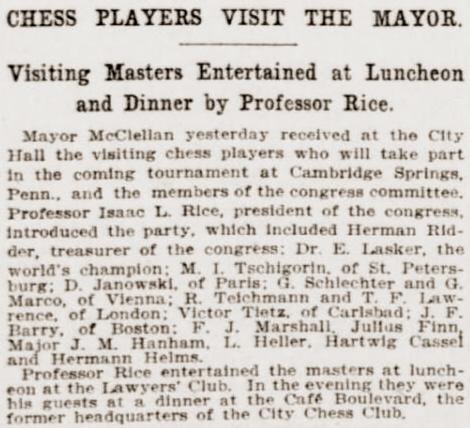
Mr Thimognier also points out that an Internet search confirms that the building in the photograph is the New York City Hall. He offers the following key:
Foreground (left to right): J. Finn, F.J. Marshall, J.F. Barry, M. Chigorin, D. Janowsky, R. Teichmann, V. Tietz, C. Schlechter and J.M. Hanham.
Background (left to right): H. Ridder, I.L. Rice, Em. Lasker, H. Cassel, T.F. Lawrence, G. Marco and N.N. (L. Heller?).
(6891)
Gene Gnandt (Houston, TX, USA) has found an article by Capablanca on page 9 of the Evening Post (New York), 22 July 1916. Below are the passages concerning Teichmann:
‘Emanuel Lasker in a Contemporary’s Eyes
Chess master not a peculiar type of individual
Capablanca, the Cuban Player, in an Estimate of the Abilities of the World’s Champion – His Personal Characteristics – Tarrasch and Teichmann as They Appear in Tournaments – Tarrasch, Only, Prepares for ContestsBy José Raoul Capablanca
I have frequently heard the remark that a chess master must be a peculiar type of individual. He must not be one who sticks close to the golden mean of conduct, but rather one who approaches extremes, if not in physical, at least in mental, characteristics. With this statement I must say on the strength of my associations with the chess masters of the world, that I am not wholly in accord. It is true that they are, with few exceptions, men of great mental powers.
In this connection there come to my mind the mental pictures of three of my worthiest German opponents – Emanuel Lasker, Tarrasch and Teichmann. I shall speak of these three not only because their pre-eminence demands it but also because my observation of them makes me believe that they possess some of that picturesqueness and oddity suggested by the usual caricature of the chess master.
...
Richard Teichmann is a player who combines the qualities of both Lasker and Tarrasch. Like Lasker, Teichmann has Bohemian tendencies. He is an accomplished linguist; cannot extend himself to his best effort unless his whiskey and soda are at close call; and is clever at all games of cards and billiards. Work is no virtue with him, despite his massive bulk. As soon as his money is gone, he sets about to play chess.
As a result of an explosion, Teichmann lost the sight of one eye. And I recall with what amusement, in the midst of a brilliant gathering at Petrograd, we received the observation of a spectator that, if Teichmann could see so much in chess with one eye, what might he be capable of if he possessed two?
Teichmann won his first tournament at Carlsbad in 1911, after 20 years of play, and only after he had gone to Switzerland to prepare himself for the event. Up till then, by a strange coincidence, he had to content himself with fourth places generally. In recognition of this achievement, his friends conferred upon him the title of Richard the Fourth.
Chess to Teichmann is a pastime pure and simple. He is a keen student of the game, but plays it mostly for the pleasure that a pastime gives. He is one of those erratic players. When he has the upper hand, his play is of the most masterly kind, but at other times he is weak. Like Lasker, he does not find it necessary to come prepared. But on account of his peculiar indifference, and his disinclination to disturb the serenity of his temperament, he frequently contents himself with a draw.’
(7557)
Charles Milton Ling (Vienna) asks whether a reliable source is available in support of his recollection that the phrase ‘Genug des Stumpfsinns, Remis!’ (‘Enough tedium, draw!’) has been attributed to Richard Teichmann, who wished to attend a wrestling event rather than play chess.
We can offer a passage about Teichmann from page 58 of Ein Rundflug durch die Schachwelt by Rudolf Spielmann (Berlin and Leipzig, 1929):
‘In einer Wettkampfpartie mit Sämisch begab sich folgendes: Etwa 15 Züge waren geschehen. Sämisch glaubte nach allen Regeln moderner Schachkunst eine aussichtsreiche Stellung erlangt zu haben und war eben eifrig dabei, einen geeigneten Schlachtplan auszuhecken. Während er angestrengt nachdenkt, zieht plötzlich Teichmann die Uhr, steht auf, schiebt die Steine zusammen und bemerkt einfach: “Genug des Stumpfsinns, Remis!” Empfiehlt sich und geht in den Zirkus. Er war höchste Zeit, denn die Ringkämpfe hatten eben begonnen!’
Is it possible to find a match-game between Teichmann and Sämisch which fits this account (i.e. after about 15 moves Sämisch had an apparent advantage, but Teichmann suddenly broken off the game as a draw since he wished to watch wrestling at the circus)?
Page 43 of the February 1922 Deutsche Schachzeitung reported that a brief match between the two masters had taken place in Berlin. Teichmann won with one victory and three draws.
(8449)
Concerning the remark ‘Genug des Stumpfsinns, Remis!’ (‘Enough tedium, draw!’) attributed to Richard Teichmann, Birger Flindtholt (Randers, Denmark) has found the following (Caïssa, January 1952, page 29):
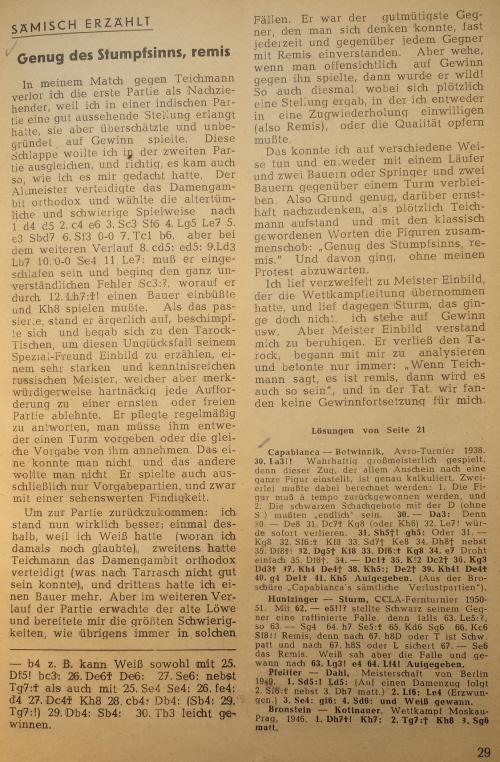
(8836)
From the first page of an article by Fred Reinfeld, ‘At What Age is a Chess Master at his Best?’, on pages 249-253 of CHESS, 14 March 1936:
‘Teichmann, who had only one eye, was famous both for his laziness and for the rather large percentage of blunders in his games. My impression of Teichmann’s play underwent a radical change when, through a mishap in the Syracuse, 1934 tournament, I was forced to play my last game with a patch over one eye. I have spent many a pleasant time at the chess board, but never have I endured four such agonizing hours as in that game where I had the use of only one eye. Since then I have had a tremendous admiration for Teichmann, and my vivid realization of his dreadful handicap has enabled me to understand his readiness to take a premature draw. The chronicle of human achievement does not include any more heroic deed than Teichmann’s first prize in one of the strongest tournaments in chess history (Carlsbad, 1911), with his fine victories in this protracted contest over Alekhine, Nimzowitsch, Schlechter, Rubinstein, Tartakower, Kostić, Spielmann – to mention only the most outstanding rivals.’
An illustration by W.H. Cozens on page 316 of the November 1961 BCM:
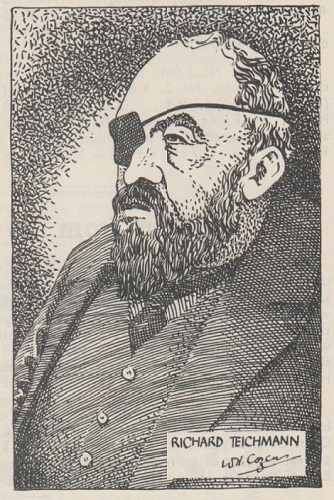
Another player who had occasion to wear an eye patch was Emanuel Lasker, during his autumn 1909 contest against Dawid Janowsky; see the photograph in our article Lasker v Janowsky, Paris, 1909.
Lasker had undergone an operation on his right eyelid, as reported on page 407 of La Stratégie, November 1909:
‘Le Dr. E. Lasker, bien que handicapé par les suites d’une opération subie à la paupière de l’oeil droit, a brillamment maintenu sa renommée en gagnant sept parties contre une perdue et deux nulles.’
(8922)
A well-known quip is that, firstly, the hypermodern school did not exist and that, secondly, Nimzowitsch founded it, and a number of C.N. items have tried to establish the origins of the remark. The best source available in C.N. 3079 was a vague reference in an “exclusive” article by Vidmar on pages 155-159 of the October 1927 issue of Mundial, a Uruguayan magazine published in Montevideo:
‘Cuando Réti, por medio de una pequeña pero hermosa obrita, trató de hacer que las nuevas ideas fueran comprensibles para la generalidad, se dice que Teichmann manifestó concisa y concluyentemente: “En primer lugar, no existe una escuela hipermoderna, y además, la creó Nimzowitsch”.’
C.N. 3251 added that the remark is to be found on page 4 of Das neuromantische Schach by S. Tartakower (Berlin, 1927):
‘Da wäre schon der Ausspruch des seligen Teichmann viel zutreffender, der auf einige Ausführungen Réti’s im Jahre 1923 mit dem ihm eigenen kernigen Humor erwiderte: “Erstens existiert die hypermoderne Schule gar nicht und zweitens stammt sie von Nimzowitsch!”’
English translation: ‘... the remark of the late Teichmann, who replied to some of Réti’s statements in 1923 with his own brand of pointed humour: “First, the hypermodern school does not actually exist, and secondly it originates with Nimzowitsch”.’
C.N. 5006 added that Reinfeld also gave the remark on page 129 of The Chess Masters on Winning Chess (New York, 1960):
‘It took Nimzowitsch 20 years of tireless preaching to achieve acceptance. So great a master as Teichmann commented dourly that “in the first place there is no Hypermodern School, and in the second place Nimzowitsch is its founder”. This was a more or less polite way of saying that Nimzowitsch was crazy.’
That last remark of Reinfeld’s seems far-fetched, and it is unclear why he affirmed that Teichmann made the remark ‘dourly’. The same C.N. item added that Reinfeld on Nimzowitsch can be a strange spectacle. For example, also on page 129 of The Chess Masters on Winning Chess he wrote: ‘By the time Nimzowitsch was 20, he had perfected his system.’ In his revised edition of Nimzowitsch’s My System (Philadelphia, 1947) Reinfeld stated (page xxi) that ‘by 1906, when he was only 20, Nimzowitsch had definitely become a master of the very first rank’.
As pointed out in C.N. 9357, below is a remark by Fred Reinfeld on page 106 of Great Moments in Chess (New York, 1963):
‘Teichmann, a stalwart of the old school, made the surly comment that in the first place there was no Hypermodern school, and that in the second place Nimzowitsch was its founder.’
For a reliable account of Nimzowitsch’s development, readers today can rely on a magnificently researched book, Aron Nimzowitsch On the Road to Chess Mastery, 1886-1924 by Per Skjoldager and Jørn Erik Nielsen (Jefferson, 2012).
See too Hypermodern Chess.
From page 8 of the Standard, 8 March 1897:
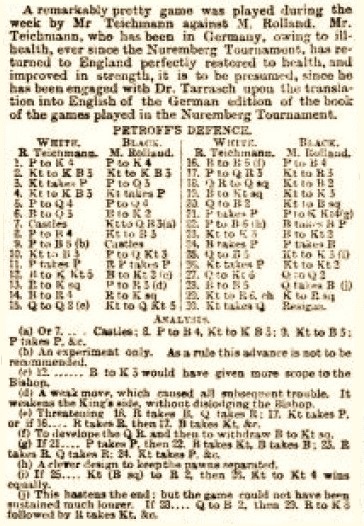
1 e4 e5 2 Nf3 Nf6 3 Nxe5 d6 4 Nf3 Nxe4 5 d4 d5 6 Bd3 Be7 7 O-O Nc6 8 c4 Nf6 9 c5 O-O 10 Nc3 b6 11 cxb6 axb6 12 Bg5 Bb7 13 Re1 h6 14 Bh4 Re8 15 Qd2 Nb4 16 Bf5 c5 17 a3 Na6 18 Rad1 Nc7 19 Bb1 Ne6 20 Qc2 Nf8 21 dxc5 g5
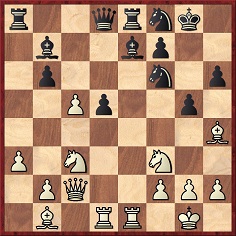
22 c6 Bxc6 23 Ne5 Bb7 24 Bxg5 hxg5 25 Qf5 Ne6 26 Nxf7 Ng7 27 Qg6 Qd7 28 Bf5 Qxf5 29 Nh6+ Kh8 30 Nxf5 Resigns.
(9676)
‘The immortal Tarrasch glibly explained that his disappointing play at the Hastings Tournament in 1895 was caused by the sea air.’
In C.N. 5724 a correspondent quoted that remark from page 10 of Why You Lose at Chess by Fred Reinfeld (New York, 1956 and London, 1957). Below is the full section (on pages 10-11), which includes ‘one of the most fantastic stories in the history of tournament play’:
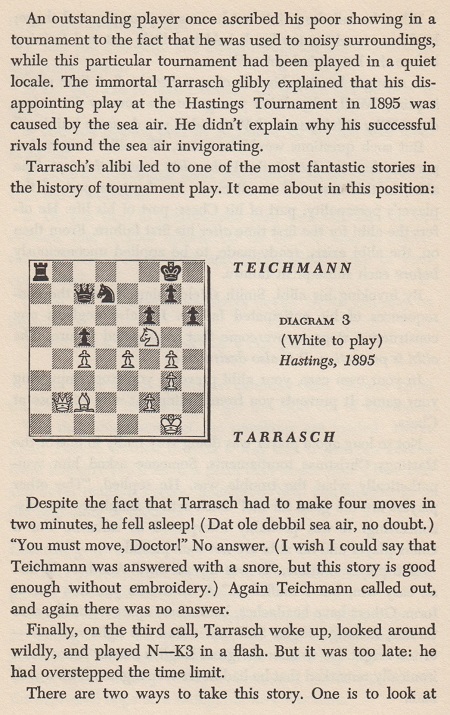
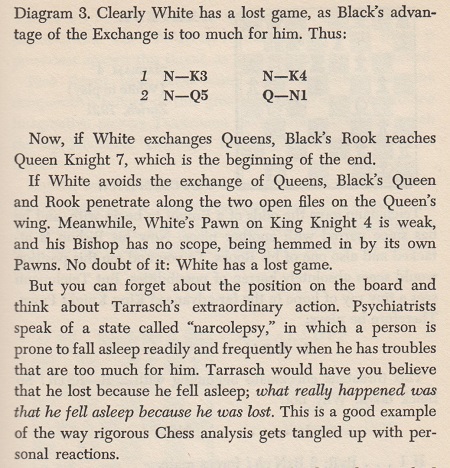
We note the following on pages 182-183 of Das internationale Schachturnier zu Hastings im August-September 1895 by E. Schallopp (Leipzig, 1896), at the end of the Tarrasch v Teichmann game:
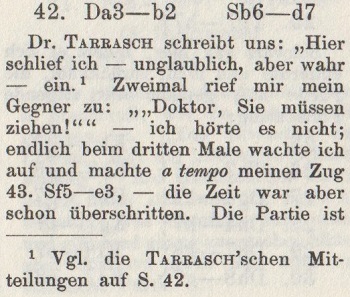

Tarrasch’s remarks on page 42, as referred to in the footnote:
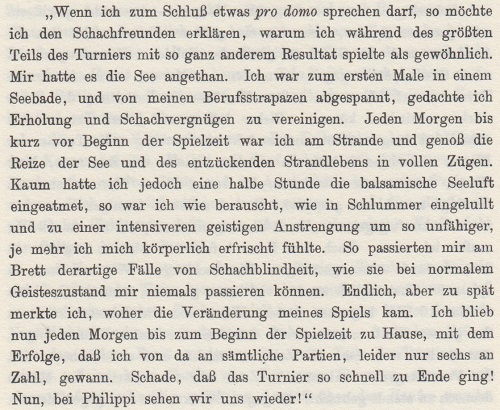
(10017)
Hans Renette (Bierbeek, Belgium) notes in holdings of the Jack O’Keefe Project an article by Pillsbury in the Philadelphia Inquirer of 3 September 1905 which discussed Teichmann’s eyesight in connection with the game Teichmann v Leonhardt, Ostend, 16 June 1905.
We add that the column appeared on page 2 of the Comic Section of the Inquirer:
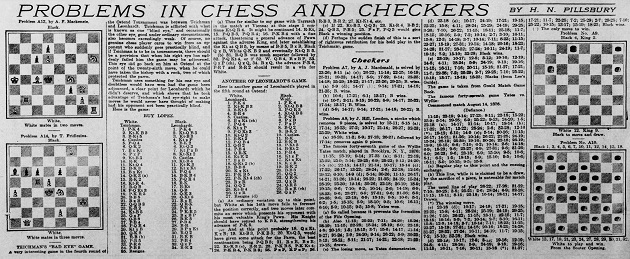
(10248)
1 e4 e5 2 Nf3 Nc6 3 Bc4 Nf6 4 d4 exd4 5 O-O Nxe4 6 Re1 d5 7 Bxd5 Qxd5 8 Nc3 Qh5 9 Nxe4 Be6 10 Bg5 Be7 11 Bxe7 Nxe7 12 Qxd4 O-O 13 Ng3 Qh6 14 Rad1 Nc6 15 Qa4 Rad8 16 Nd4 Nxd4 17 Rxd4 Rxd4 18 Qxd4 b6 19 Qe5 c5 20 f4 Bc8 21 f5 Qc6 22 Qe7 Bb7 23 Re2 Qd5 24 h3 b5 25 Kh2 (As will be seen below, there is no unanimity over the move-order in this phase.) 25...f6 26 Ne4 c4 27 Nd6 Bc6 28 c3 h6 29 Kg3 a6 30 Kh4 g6 31 Re3 Qxg2 32 Rg3 Qf2 33 fxg6 Qf4+ 34 Rg4 Qf2+ 35 Kh5 Qc5+ 36 Kxh6 Resigns.
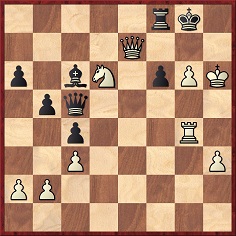
From Alan McGowan (Waterloo, Canada):
‘It appears that the well-known game Teichmann v Allies, supposedly played in Glasgow in 1902, actually occurred there three years later.
The game is in various books and databases, and Teichmann’s use of his king in the closing stages is a winning idea seen in Short v Timman, Tilburg, 1991. There are slightly different versions of the Teichmann game, and, for instance, page 75 of L. Pachman’s Modern Chess Strategy (London, 1963) had 28 Kh2, 29 Kg3 and 30 Kh4, whereas White appears to have placed his king on h2 a few moves earlier:
I have noted this reference to the game on page 8 of the Falkirk Herald, 20 September 1905:
Page 8 of the Falkirk Herald of 15 March 1905 gave the dates of some of Teichmann’s engagements:
Monday, 13 March: Queen’s Park Chess Club
Tuesday, 14 March: Central Chess Club
Wednesday, 15 March: Stirling
Thursday, 16 March: Falkirk Chess Club
Friday, 17 March: Burns Chess Club.The Queen’s Park, Central and Burns Chess Clubs were all in Glasgow.’
We add the game’s appearance on page 11 of section two of the 11 June 1905 New Orleans Times-Democrat:
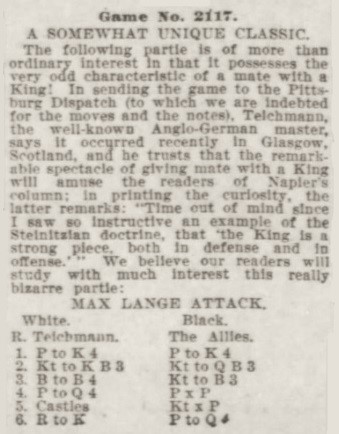
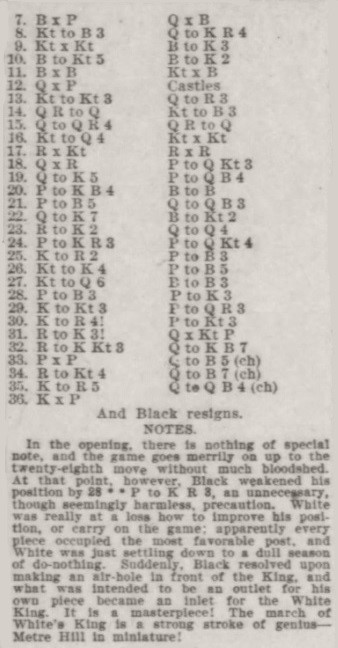
John Hilbert (Amherst, NY, USA) has forwarded us a photocopy of the game’s original publication, by W.E. Napier, in the Pittsburg Dispatch of 5 June 1905.
Teichmann had also visited Glasgow in 1901-02, for four months (BCM, February 1902, page 60), but Napier’s report of the communication from Teichmann indicates that the king-march game was played recently, i.e. in March 1905.
No publication of the game prior to 5 June 1905 has been found, and we wonder when the date 1902 was first proposed. An early instance in a book is the first edition of Edward [Eduard] Lasker’s Schachstrategie (Leipzig, 1911), pages 100-102:

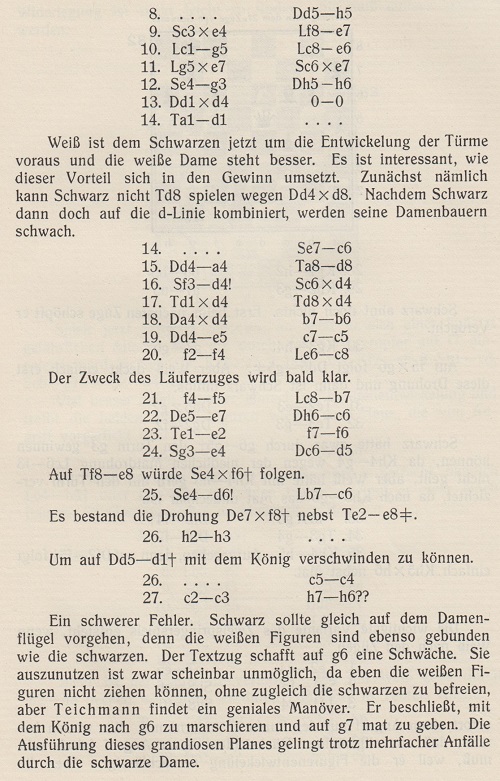
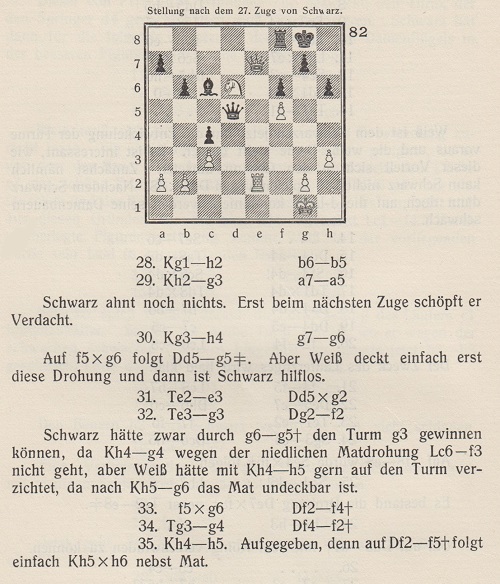
As mentioned in C.N. 7933, Beratende is a German word for consultants/allies. In Lasker’s final note, a move by the black queen to c5 (QB4), and not f5 (KB4), was evidently meant. The move order given by Lasker included the sequence 28 Kh2, 29 Kg3 and 30 Kh4, as in the Pachman book but also, strange to say, as in item 114 of Unit Two of Napier’s Amenities and Background of Chess-Play (New York, 1934), which, moreover, had the date 1902. See too pages 167-168 of Paul Morphy and The Golden Age of Chess by W.E. Napier (New York, 1957 and 1971).
(10798)
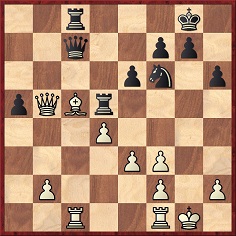
Black not to move
This position was discussed by Al Horowitz on pages 112-113 of How To Win in the Middle Game of Chess (New York, 1955), in the section about perpetual check:
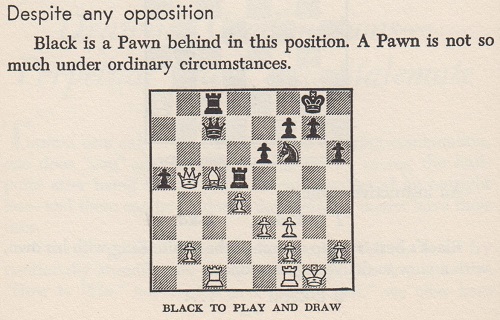
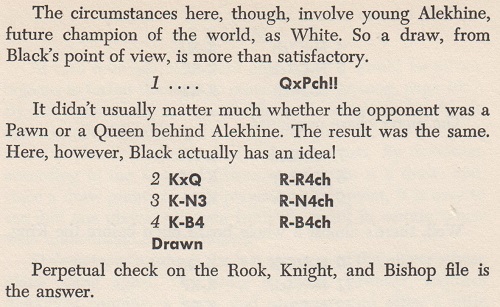
The text had previously appeared in an article by Horowitz on pages 87-89 of Chess Review, March 1954.
The play by ‘young Alekhine’ occurred when he was 30, against Teichmann at Carlsbad, 1923. The game was drawn, though later on and not by perpetual check; Teichmann could not sacrifice his queen in the diagrammed position because it was White’s move. Alekhine played 27 f4.
The situation after 26...Rd8-d5 was discussed on page 118 of the tournament book:
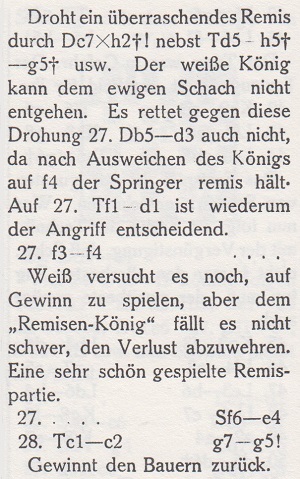
The complete game: 1 d4 d5 2 c4 e6 3 Nf3 Nf6 4 Nc3 Be7 5 Bg5 Nbd7 6 e3 O-O 7 Rc1 c6 8 Qc2 Re8 9 Bd3 h6 10 Bf4 dxc4 11 Bxc4 b5 12 Bd3 a6 13 a4 Bb7 14 O-O Rc8 15 Qb3 Qb6 16 Ne5 Red8 17 Ng6 Bf8 18 Nxf8 Nxf8 19 Ne4 Nxe4 20 Bxe4 Nd7 21 Bd6 Nf6 22 Bc5 Qc7 23 Bf3 a5 24 axb5 cxb5 25 Qxb5 Bxf3 26 gxf3 Rd5 27 f4 Ne4 28 Rc2 g5 29 f3 Nxc5 30 Rfc1 Rb8 31 Qe2 gxf4 32 dxc5 fxe3 33 Qxe3 Rg5+ 34 Kh1 Qc6 35 Rg1 Rxg1+ 36 Kxg1 Qd5 37 Rd2 Qf5 38 Rg2+ Kh7 39 Qe4 Qxe4 40 fxe4 Rc8 41 Rc2 Kg6 42 Kf2 Kf6 43 Ke3 Ke5 44 Kd3 f6 45 Rc4 f5 Drawn.
The opening was examined by Alekhine in his first Best Games book, in the annotations to his brilliancy-prize victory over Rubinstein in the first round of the same tournament.
(10867)
This game was published on page 7 of the Standard, 3 January 1894:
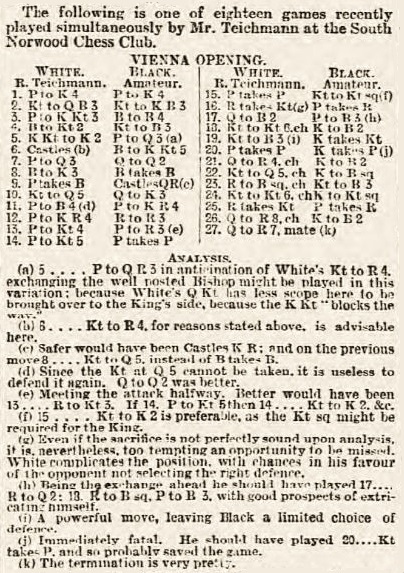
1 e4 e5 2 Nc3 Nc6 3 g3 Bc5 4 Bg2 Nf6 5 Nge2 d6 6 O-O Bg4 7 d3 Qd7 8 Be3 Bxe3 9 fxe3 O-O-O 10 Nd5 Qe6 11 c4 h5 12 h4 Rh6 13 b4 a6 14 b5 axb5 15 cxb5 Nb8
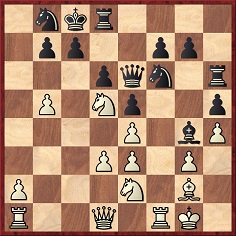
16 Rxf6 gxf6 17 Qc2 c6 18 Nb6+ Kc7 19 Nc3 Kxb6 20 bxc6 Kxc6 21 Qa4+ Kc7 22 Nd5+ Kc8 23 Rc1+ Nc6 24 Nb6+ Kb8
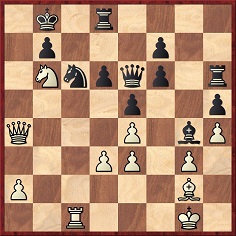
25 Rxc6 bxc6 26 Qa8+ Kc7 27 Qa7 mate.
Page 21 of the January 1894 BCM reported that Teichmann’s display (+15 –1 =2) at the South Norwood Chess Club was on 15 December 1893.
(10889)
An extract from our translation of a tribute by Capablanca to Géza Maróczy which did not appear in the English edition of the Cuban’s radio Lectures but was included on pages 149-154 of the Spanish version, Lecciones elementales de ajedrez (Madrid, 1973):
‘The great master Teichmann had great respect for his [Maróczy’s] ability. I remember that during the International Tournament at San Sebastián in 1911, Teichmann spoke to me one day about the competitors, saying: “Maróczy is a very profound player and he plays the endgame very well; at his best he is a very dangerous opponent in this kind of tournament.”
As listeners will know, this was my first tournament in Europe, and I had the good luck to win it. At that time I did not know the great European masters, and it was only through the kindness of some of them, such as Teichmann, Schlechter, Maróczy and Tarrasch, that I found out about the qualities and strengths of each master. The Russians, represented by Rubinstein, Bernstein and Nimzowitsch, kept themselves apart and were not as amiable as the other players. From everything that was said it was possible to deduce that Tarrasch, Schlechter, Maróczy and Rubinstein were considered the strongest.’
For the full text, see Capablanca on Maróczy.
To the Archives
for other feature articles.
Copyright Edward Winter. All rights reserved.